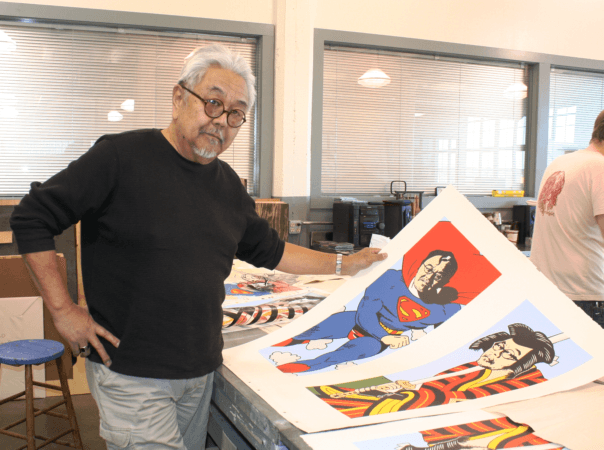Roger Shimomura: An American Knockoff
From the KCUR’s Arts & Culture desk, a service of Kansas City Public Media
Seventy years ago, on February 19, 1942, President Franklin Roosevelt signed Executive Order 9066. This action, just a few months after the Japanese attacked Pearl Harbor, forced an estimated 120,000 Japanese Americans into internment camps.
Kansas-based artist Roger Shimomura was one of them. A young child at the time, the memories of barbed wire and guard towers have influenced his artwork ever since.
Shimomura’s paintings are featured as part of the Smithsonian’s National Portrait Gallery exhibition Portraiture Now: Asian American Portraits of Encounter (in Washington DC through October 14). Roger Shimomura: An American Knockoff, a solo show, is on view online via Kansas City’s Byron Cohen Gallery through the end of this month.
It’s an early afternoon in January. Roger Shimomura, with spiky white hair, a goatee, and round glasses stands near a long table at Lawrence Lithography Workshop on Kansas City’s east side. Spread out before him on creamy sheets of paper are two brightly colored prints.”The two prints that (master printer) Mike Sims has just completed, one is of me, my face as Superman. Another print (is) of myself in a Kimono,” he says.For decades, in his prints, paintings, and performances, Roger Shimomura has explored Asian-American stereotypes and issues of ethnic identity with pop culture in the mix.
Shimomura’s grandparents were from Japan, but he was born in Seattle, Wash. When he was a toddler, he and his family were sent to Camp Minidoka, an internment camp in Idaho. It was one of ten camps where Japanese Americans were relocated during World War II.”It was 1998, I think, when my New York dealer asked everyone in her gallery to try to recall their first 10 memories of life,” says Shimomura. “And mine were all in the camp.”
Images in his work are also drawn from family photos and his grandmother Toku Shimomura’s diary. She kept a daily record for nearly six decades, including the years in the camp.
October 16, 1942:
“How monotonous life is here. Again, another day passed wastefully doing laundry and miscellaneous things.
I wondered how anyone in this camp could live here without a deep sense of boredom.”
This was a shared history that was not discussed. Shimomura says an entire generation, like his parents, second-generation Japanese Americans known as the Nisei , probably suffered the most.”They were the ones who really took the brunt of the trauma,” he says. “For years and years, they collectively never spoke about it.”
After graduate school in Syracuse, N.Y., Shimomura moved to Lawrence in 1969 to teach at the University of Kansas.”I’ve always said that had I not come to Kansas my artwork would probably be something entirely different than what it turned out to be,” he says.Shimomura recalls he was one of only a handful of Asian-Americans on the KU campus then. He was often asked, as he still is sometimes today, how he speaks English as well as he does.”They’re looking, but they’re not listening. And they see an Asian face, and there’s something about an Asian face that always reads as foreign,” says Shimomura. “And it was in really some ways a matter of survival that I ended up doing the kind of art that I was doing, to sort of mediate my ethnic presence in the Midwest.”
United States Artists recently awarded Roger Shimomura a $50,000 USA Ford Fellowship; it honors artists for a lifetime of work. And three separate exhibitions of Shimomura’s work are traveling the United States right now. His series An American Knockoff includes self-portraits, like “Shimomura Crossing the Delaware.” He says he’s learned the importance of humor.”You could laugh at every one of these paintings, and there’s an element of humor and lightheartedness,” says Shimomura. “I think that if you’re a thinking person and take a half step in my direction, there’s also a lot of pain and agony embedded in the work.”
Every summer, Shimomura drives from Lawrence, Kansas to Seattle, Washington. He tries to time the trip with the annual Minidoka Pilgrimage, when other camp internees return with their families. He says more stories are being told. To hear the older generation speak vividly — after years of saying nothing — is something he looks forward to each year.
Slideshow: Roger Shimomura
We want to hear your feedback so we can keep improving our website, theworld.org. Please fill out this quick survey and let us know your thoughts (your answers will be anonymous). Thanks for your time!
